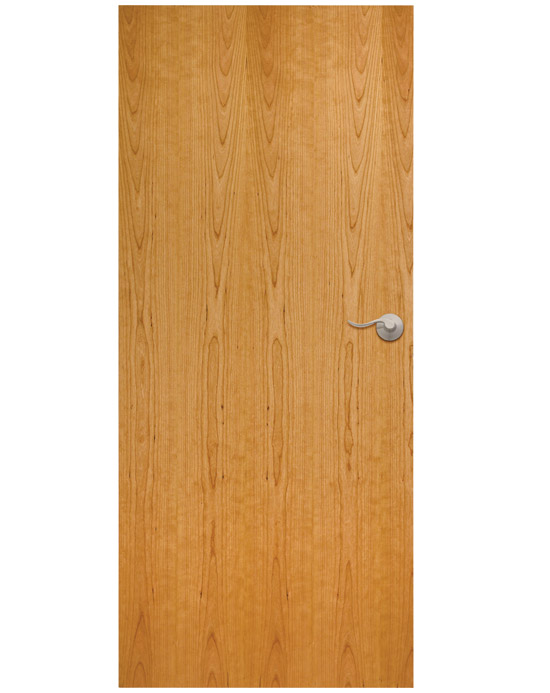What Architects Need to Know About Specifying Wood Doors
Aesthetic Concerns
A key way to assure the aesthetics of an architectural hard wood door is to focus on veneer and how the veneer components are matched.
Matching of Veneer Components
Once the decorative veneer cutting method is specified, the type of match at the joint line must be specified. The way in which the individual cuts are placed next to each other during the fabrication of the veneer face affects the appearance and aesthetic of a door. Leaf matching and assembly matching must be considered, as well as the matching of pairs of doors, sets of doors, and doors with transoms.
Book matching . The most commonly used method to match veneer leaves in the wood architectural door industry is known as book matching. Book matching requires every other piece of veneer to be turned over so adjacent pieces, or leaves, are “opened” like the pages of a book. The veneer joints match and create a mirrored image pattern at the joint line, yielding a maximum continuity of grain. It is commonly used with plain sliced cut and less often with other cuts of veneer. A natural result of veneer slicing is the accentuation of the dark-light-dark-light appearance of the veneer. Because the “tight” and “loose” faces alternate in adjacent pieces of veneer they may accept stain or reflect light differently resulting in a noticeable color variation, often called “barber pole.” These variations are not considered a manufacturing defect.
Slip and random matching. Slip match is the adjoining of veneer components in sequence without turning over every other piece. The grain figure repeats, but joints do not show a mirrored effect. Slip matching is often used in quarter cut, rift cut, and comb grain veneers to minimize the barber pole effect. Random match produces a “board like” appearance and is not recommended for finished applications. The random selection of veneer components from one or more logs is most commonly used in opaque and “good” grade door applications.
Assembly Match
In addition to leaf matching, a type of assembly match must be specified. To obtain the desired aesthetics, any sequence matching from door opening to door opening must be detailed.
Running match. Running match is the most common type of assembly splice used. Each face is assembled from as many veneer pieces as necessary creating a non-symmetrical appearance on any single door face. Veneer pieces of unequal width are common. Running match yields the least amount of waste veneer and is recommended by WDMA Quality Standards.
Balance match. This type of match creates a symmetrical appearance. Each piece is similar in size and each face is assembled from an even or odd number of pieces of uniform width veneer before trimming. The piece in the middle of the group is centered around the mid-point of the veneer face. This type of match reduces veneer yield.
Center balance match. Also creating a symmetrical appearance, center balance matching is a technique by which each face is assembled from an even number of veneer pieces of uniform width before trimming, with a veneer joint or splice in the center of the door face. Achieving a center balance match creates the most waste veneer, because it reduces the veneer yield and is considered the least “green” choice for assembly matching. It is the most expensive in terms of waste, price, and our environment.
Doors in pairs. Wood doors may be, and in some grades, must be specified as pair matched where appropriate. Pair matching consists of using the same assembly match to pairs of doors or a series of doors pairs in the immediate vicinity. Most architectural wood door manufacturers will pair match doors unless they are produced with an opaque finish that hides the grain.
Doors in sets. Set match describes the way in which the leaves of veneer are assembled for sets of doors hung adjacently. Doors in single openings may also be set matched but this must be specified in the design document and when orders are placed so manufacturers can order veneer appropriately.
Doors with transoms. For doors with transoms, continuous matching is recommended. Continuous match means that a single piece of veneer is utilized for both the face of the door and the transom. The ability to provide this match is dictated by the length of the log. Continuous match provides optimum veneer utilization as each single piece of veneer extends from the bottom to the top of the door. In some species, 10-foot cuts of veneer may be available, but in others only shorter lengths may be obtainable.
 |
Book Running Door Image courtesy of VT Industries, Inc. |
Each face and transom of an end match door is produced from two sheets of veneer. A single piece of veneer extends from the bottom to the top of the door and a mirror image is created at the transom by turning the veneer at the joint. End matched panels are used when veneers are not long enough to cover the whole height of the door with a single face on each side. For doors with transoms, “no match” is possible but it is not typically specified in architectural wood doors since it has an undesirable, unattractive appearance.









